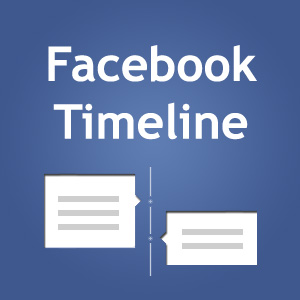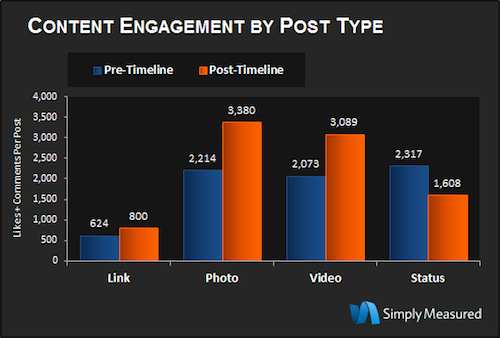 Catching up on reading last night, I saw this article in MarketingLand about a study done on the new Facebook timeline. The use of rich media in Facebook content strategy is paying off – even at the early stages.
Catching up on reading last night, I saw this article in MarketingLand about a study done on the new Facebook timeline. The use of rich media in Facebook content strategy is paying off – even at the early stages.
While admittedly, a study that involves only 15 participants immediately invites skepticism, nonetheless, the results of the SimplyMeasured early adopter study weren’t surprising. Facebook engagement per post after integration of Timeline for the brands in the study was up on average 46%.
 We’ve written a lot about the Facebook timeline over on the V3 blog, and to our way of thinking, one of the biggest benefits of the new Timeline pages for brands is the ability to provide better, more compelling visuals and, hopefully as a result, derive more engagement from brand fans. Heck, I don’t even drink soda, yet visiting the Coca Cola Facebook page is one of my favorite pastimes—if only to see what they’re up to now. And rich media is a huge part of the reason for success. Think I’m crazy, almost 26,000 people “liked” this picture of a frosty, cold Coke, and another 1,100 took time to comment on it. Think you’re going to get that kind of fan engagement by posting a link?
We’ve written a lot about the Facebook timeline over on the V3 blog, and to our way of thinking, one of the biggest benefits of the new Timeline pages for brands is the ability to provide better, more compelling visuals and, hopefully as a result, derive more engagement from brand fans. Heck, I don’t even drink soda, yet visiting the Coca Cola Facebook page is one of my favorite pastimes—if only to see what they’re up to now. And rich media is a huge part of the reason for success. Think I’m crazy, almost 26,000 people “liked” this picture of a frosty, cold Coke, and another 1,100 took time to comment on it. Think you’re going to get that kind of fan engagement by posting a link?
The SimplyMeasured study looked at various types of content posted on the brand pages studied and found that in all cases, all types of content shared were up – except for status updates. And the content that drove the largest share of engagement—photos (up 52%) and videos (up 49%). This is something we work with our clients on on a daily basis and if you’re not focusing on how you can use rich media in all of your content marketing efforts – including your Facebook marketing strategy, you’re missing the boat.
It’s a fact that people respond better and more often to visual content. Emails that have video embeds historically have 2-3 times higher click through rates. Twitter posts that include photos or video tend to drive more traffic and see more clicks. And, as mentioned by this study rich media is definitely a key to success when it comes to Facebook marketing.
And by the way, if all you’re doing with your Facebook brand page is posting links—before or after the mandatory Timeline switchover, you’re pretty much wasting your time. Facebook is for storytelling, conversation, entertainment and engagement. If you’re just posting a link once or twice a day it’s akin to walking into a roomful of people – all of whom either are friends or who might be interested in what you have to say, dropping a piece of paper on the floor and leaving. Who in the world would do that? And if you’re shaking your head at the analogy but your Facebook “strategy” is limited to posting links without any kind of commentary or anything else, you’re that guy. And nobody really likes that guy.
If you need some help with your Facebook Timeline strategy, feel free to mosey over and check out our post on How to Maximize Facebook Timeline For Your Brand or Business Page.
Another terrific post, this one in whitepaper form, was created by my friend David Jones for Proximity’s SocialWork. It’s pretty awesome. As is David. But please, do NOT tell him I said that.
One final point: please don’t let all the hype about Facebook’s Timeline for Pages make you crazy. Sure, if you’ve managed to create a vibrant community there and have many fans, it’s important. But if you’re in the infancy stages of using Facebook as a content marketing/engagement channel and are one of the many who have less than the average 256 Facebook fans, don’t sweat it. If you don’t get your page transitioned before the mandatory move (which is today, 3/30/12), it’s not the end of the world. Your page will still be there. It won’t look hideous. And there’s plenty of time to get this done. But if you have a choice between focusing your efforts on this or going out and selling something to somebody – by all means, go do that! Just don’t wait forever.
Lead image via TechBend
[recent posts]
